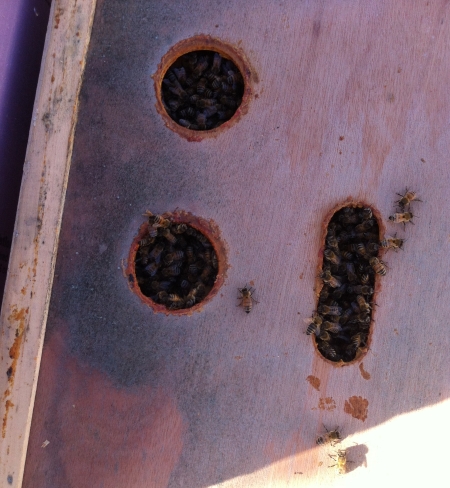
Getting the rest of the gear. No assembly required!
- You still need protective gear, on which I have some strong opinions.
- You need tools to pry the boxes and frames apart.
- You need a smoker, too. And a spritz bottle (NEW not re-used)
- You need stuff to feed the bees.
- And finally you need mite control products. Let's get into these...
Protective gear
It is up to you to decide what to wear so you feel comfortable working the bees. That
includes being able to feel the frames and your tool, to see fine details
on frames, and to not be too hot. And to be sure no bees are crawling
under anything you're wearing, like your pants or bee jacket.
- Here are a few Do Not's.
- Gloves. I still wear gloves (more on that below), but DO NOT use the goatskin gloves from bee stores. DO NOT use black, dark blue or red/dark red (looks black to bees). The bees think it's a bird pecking at the top of their colony! And no furry-backed garden or work gloves.
- Veil/jacket Do not get a canvas jacket or suit (unless you plan on having water handy - to dump on the canvas as the day progresses). Do not lift the lid without a veil on.
And that's the end of my "Do Not's".

Gloves: I recommend using 5 mil or better blue nitrile gloves,
never black.
Veil: I recommend getting a veil, even if you get a jacket. You can get a veil that
goes over your shoulders, called a bee vest with fencing veil.
The hat-only veils are supposed to be anchored with a strap, and I haven't figured out how to
do that, to be honest. But generally they are easier to see through.
Jacket (optional):I recommend a mesh jacket, like the ultrabreeze
or Bee Kool jackets.
No, bees can't sting through that 3 layer mesh. If you have to have a jacket, this is the one.
BUT! the veil part is hard to see through. I find it really annoying, and mine
has a few holes anyways, so I will be somehow stitching a different veil on.
Hive tools and other gadgets.
- You must have the following to work the bees safely and comfortably:
- Two hive tools, try 2 different kinds, but definitely 2 total, and maybe hide a 3rd one somewhere safe where you can find it again... they go missing. Maybe 4. Doesn't matter what kind. I like the "Italian style", if you aren't sure, get 2 different ones.
- A Frame Grip. Note that this is ONLY TO BE USED FOR THE FIRST FRAME. That first frame gets glued pretty solidly into the hive over time. You may not need this tool until August. Again, DON'T use this for every frame.
- A smoker, I like the short one, everyone says to get the tall one, your choice. I use coarse pine shavings as the fuel. Pine Shavings Must Be Stored Somewhere Dry, Unlike Your Barn Or Garage Or Shed. Oh and I love-love-love the propane torch kit for lighting the smoker. So much better than matches or... well, anything else!
- A Queen Excluder. I like the wood-framed ones, but they need painted. They come in handy in a lot of ways, as you'll see below...
Equipment for Feeding.
25 lb bag of sugar. Maybe 4 bags total. Wha-aat? Aren't bees essentially wild animals? Can't they forage on their own? One answer to this:
only 10% of wild swarms survive their first winter. We want better odds than that... so we feed. Intelligently.
If the temps will be below 50 for more than 1 week after you get the bees,
then I suggest using winter patties, and one pollen patty.
Place above the frames, then put
the inner cover on, then the lid. If that's too tall for the inner cover, use a towel
or piece of heavy canvas as your inner cover, and put the lid directly on the patties.
If the temps will be above 50 for more than a week after you get the bees: then I recommend using either 2 mason jars above the inner cover, with their lids pierced about 15 times with a small nail or thumbtack, or a pail feeder for bees. Also use a "pollen patty", not a "winter patty". I actually used a hole-saw bit on my drill to make mason-jar sized holes in my inner cover, so I can just put the jars on without opening the lid to a space full of bees. Mix 2 part sugar to 1 part water (not a typo), and plan on feeding 1 quart/day when the weather is warm. For a new hive, I do 2 quarts every 2 days.

Mite Treatment.
The first week you have the bees is a great window during which to treat for mites. I recommend Apivar, which comes in a 10-pack. You can save this for quite a while; store at room temp. Each strip is individually wrapped. You'll use again in the fall.